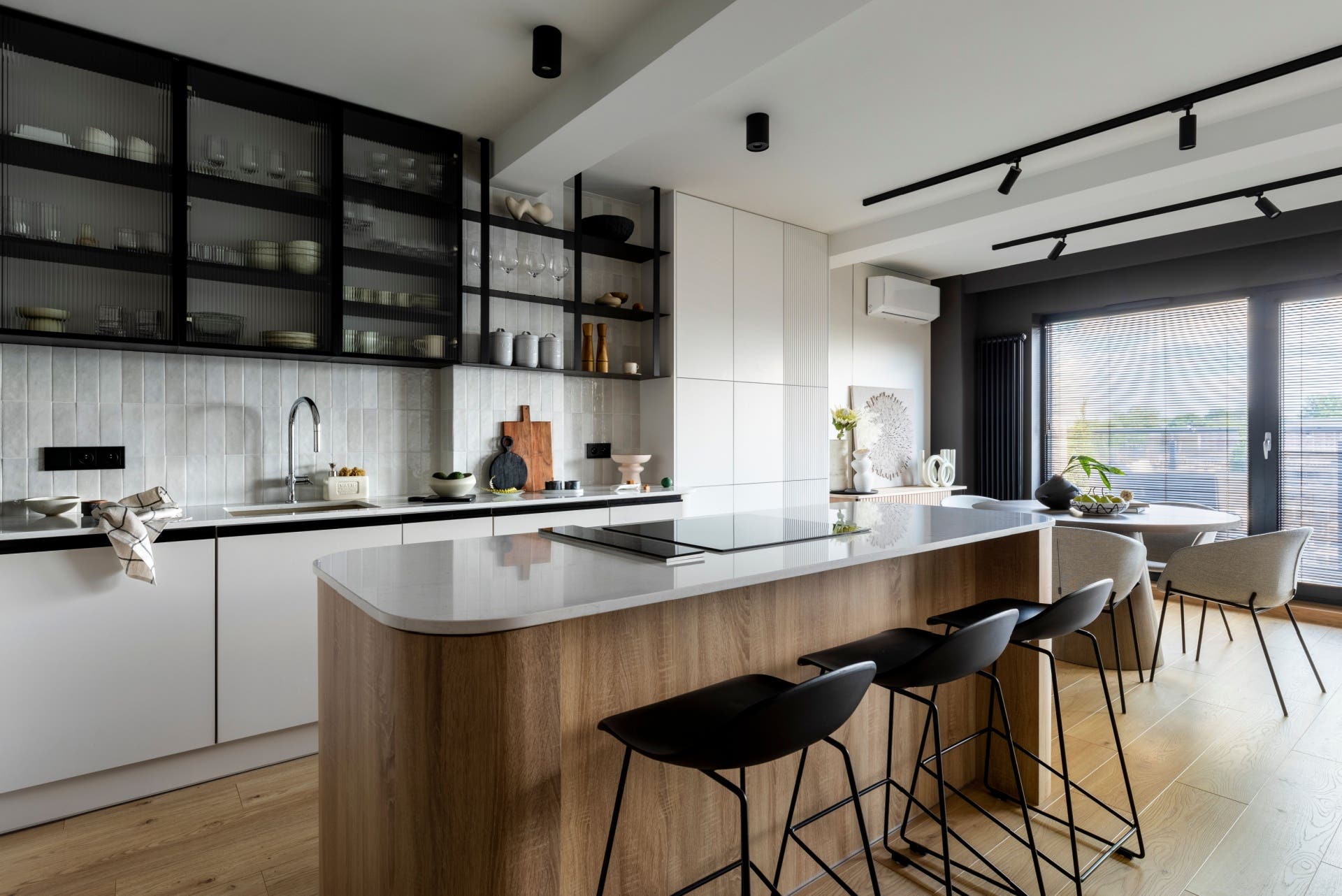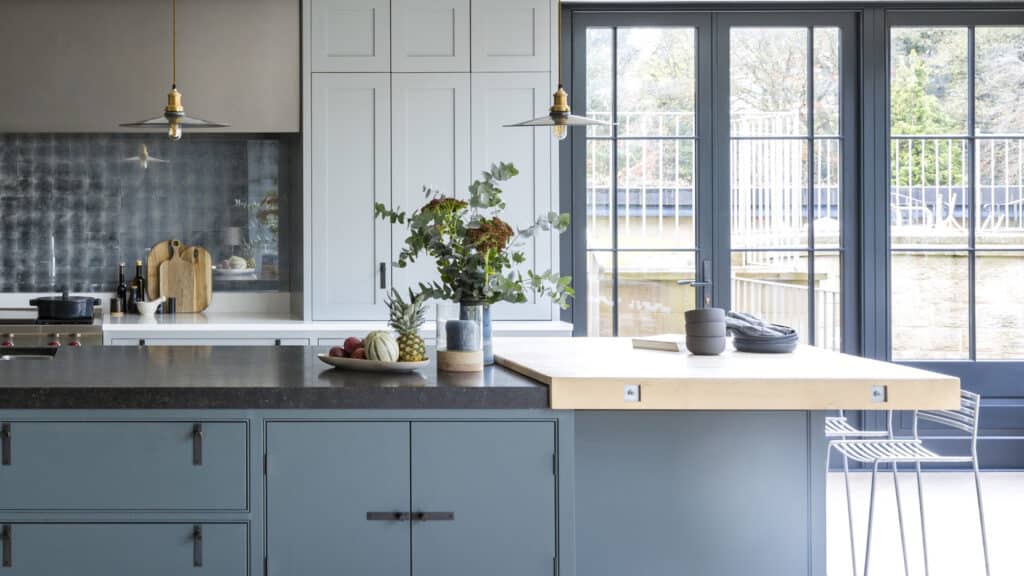By Top Drawer Cabinetry– Quality Custom Cabinetry Supplier in Phoenix, Arizona
Introduction: The New Era of Kitchen Design
Gone are the days when kitchens followed a single design aesthetic. Today’s kitchens are evolving into dynamic, multi-dimensional spaces where different materials blend harmoniously to create a visually appealing and highly functional environment. The trend of mixing materials—wood, metal, glass, stone, and more—has gained immense popularity as homeowners and designers alike seek to add texture, contrast, and personality to their kitchens.
Combining textures creates depth, adds warmth, and gives a kitchen a curated, high-end look. Whether you’re designing a new kitchen or remodeling an existing one, understanding how to mix and match different materials can help you achieve a space that is both stylish and practical.
Why Mix Materials in the Kitchen?
Mixing materials in kitchen design is not just about aesthetics—it enhances functionality, durability, and individuality. Here’s why homeowners and designers are embracing this trend:
1. Enhanced Visual Appeal
- Different textures create contrast and make the space feel more dynamic.
- Mixed materials prevent a monotonous or overly uniform look.
- Natural materials bring warmth, while industrial elements add a sleek modern touch.
2. Added Depth and Dimension
- A single-material kitchen can feel flat; incorporating various textures creates layers and interest.
- Light-reflecting materials such as glass or metal contrast beautifully with matte finishes like wood or stone.
3. Functionality and Durability
- Choosing the right materials for specific areas enhances longevity and practicality.
- For example, stone countertops offer resilience, while wood cabinets provide a warm, inviting ambiance.
4. A Personalized and Unique Aesthetic
- Mixed materials allow homeowners to create a kitchen that reflects their personal style.
- No two kitchens look exactly alike when you incorporate multiple textures and materials.
Key Materials to Mix in Kitchen Design
1. Wood: The Classic Warmth
- Wood brings warmth, character, and natural beauty to any kitchen.
- Works well for cabinets, islands, and open shelving.
- Pairs beautifully with metal, stone, and glass elements.
2. Metal: Industrial Meets Modern
- Metal accents (stainless steel, brass, or matte black) create a sleek, contemporary look.
- Ideal for hardware, light fixtures, and cabinet detailing.
- When paired with wood, it creates an elegant contrast of warmth and coolness.
3. Stone: Durable and Timeless
- Natural stones like marble, granite, and quartz offer durability and sophistication.
- Great for countertops, backsplashes, and flooring.
- Works well with wooden cabinetry for a balanced look.
4. Glass: The Elegant Transparency
- Glass-front cabinets or shelving add openness and brightness to a kitchen.
- Helps break up heavy materials and creates a sense of airiness.
- Pairs well with wood and metal for a balanced mix of textures.
5. Concrete: The Modern Industrial Edge
- Concrete countertops, floors, or walls add a raw, industrial feel.
- Works well with wood and stone to soften the overall look.
- Stained or polished concrete provides a sleek, contemporary vibe.
6. Ceramic and Tile: Artistic and Practical
- Patterned tiles add personality and a pop of color.
- Ideal for backsplashes and accent walls.
- Pairing with wood or metal enhances the kitchen’s overall character.
How to Successfully Mix Materials in Your Kitchen
1. Balance is Key
- Avoid overwhelming the space with too many different materials.
- Stick to two or three dominant materials and use others for accents.
- Consider the 70-20-10 rule: 70% dominant material, 20% secondary, and 10% accent.
2. Contrast Wisely
- Pair light and dark materials for a striking visual effect.
- Matte and glossy finishes together create depth and interest.
- Combining organic textures (wood, stone) with industrial ones (metal, glass) enhances contrast.
3. Use a Unifying Element
- A consistent color palette helps tie different materials together.
- Repeating textures throughout the kitchen (such as wood beams and wooden cabinet doors) creates harmony.
4. Incorporate Statement Pieces
- A bold stone island or a mixed-material backsplash can be the focal point.
- Unique hardware or light fixtures bring an extra touch of style.
5. Consider Maintenance and Practicality
- Use durable materials in high-traffic areas like countertops and floors.
- Ensure finishes are easy to clean and maintain.
- Select moisture-resistant materials for areas exposed to water and heat.
Real-Life Examples of Mixed-Material Kitchens
1. Rustic Meets Modern
- Reclaimed wood cabinets paired with sleek black metal fixtures.
- Concrete countertops complement subway tile backsplashes.
- Open shelving with glass elements to balance the rugged textures.
2. Industrial Chic
- Exposed brick walls with stainless steel appliances.
- A wood island with metal barstools for an urban loft look.
- Polished concrete floors that add an industrial edge.
3. Coastal Elegance
- Whitewashed wood cabinets for a beachy feel.
- Glass pendants and brass hardware to reflect light.
- Marble countertops that add luxury and durability.
4. Classic Meets Contemporary
- Dark wood cabinets contrasted with white quartz countertops.
- A herringbone tile backsplash adding a timeless element.
- Brushed gold hardware for a modern, elegant touch.
The Future of Mixed Materials in Kitchen Design
The trend of mixing materials in kitchen design is here to stay. As homeowners continue to seek personalized, unique spaces, designers are pushing boundaries with innovative combinations. Sustainability is also playing a role, with eco-friendly materials like reclaimed wood and recycled metal becoming more prevalent.
Expect to see:
- More unexpected material pairings, such as leather-wrapped handles and concrete countertops.
- Increased use of smart materials with built-in technology.
- A continued emphasis on sustainable and eco-friendly material choices.
Conclusion: Create a Kitchen with Depth and Personality
Mixing materials in the kitchen is an exciting way to add character, depth, and a high-end aesthetic to your home. By thoughtfully combining textures like wood, metal, stone, glass, and ceramics, you can create a unique space that reflects your personality while maintaining functionality.
Whether you prefer a rustic, industrial, modern, or classic style, incorporating multiple materials ensures your kitchen stands out. With careful planning and a keen eye for balance, your kitchen can become a stunning and inviting focal point of your home.
Embrace the art of mixing materials, and let your kitchen tell a story of craftsmanship, creativity, and style.


